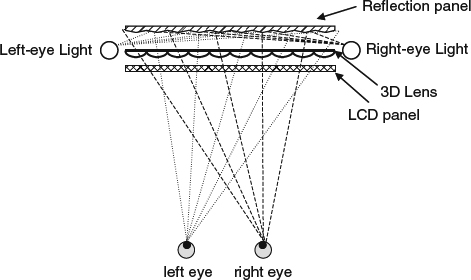9.1 Glass-Less Two-View Systems
The popularity of 3D movies has broken the ice of the 3D industry and pushed 3D technologies into commercial products and applications including 3D movies, 3D videos, 3D games, and 3D augmented surgery systems. It is not convenient for consumers to watch the 3D contents due to the requirement to wear 3D glasses when using commercially available 3D display devices. Therefore, a glass-less two-view 3D system would relieve this inconvenience. The first glass-less two-view 3D technology, the “parallax barrier” technology, was developed by Frederic E. Ives as early as 1901. It is a general belief that the quality and price of glass 3D display devices would be better than that of glass-less 3D display devices because delivering proper visual information to each eye in open space is a very hard problem. Despite of the cost and technical limitations, glass-less display devices can still be used in several 3D applications including 3D mobile smartphones, 3D portable game consoles, and 3D augmented surgery systems. This is because wearing a pair of 3D glasses may distort the view of objects in the world when smartphones and portable game consoles are used in public and not in a private space.
Stereoscopy delivers respective views of the scene to the left eye and right eye on one single display device. A glass-less two-view 3D display system, which is called autostereoscopy, must be able to deliver stereoscopic content to each eye respectively without wearing pairs of glasses. Fundamentally, autostereoscopic technologies can be divided into two categories:
- Spatially multiplexed systems: each eye sees its respective image or video in different parts of the display device at the same time.
- Temporally multiplexed systems: each eye sees its respective image or video on the same display device at different moments of time.
Details about autostereoscopy are discussed in Chapter 3. The following will only summarize those commercially available autostereoscopic systems.
9.1.1 Spatially Multiplexed Systems
Spatially multiplexed devices are widely used for portable 3D devices including Nintendo 3DS and HTC EVO 3D. There are mainly two technologies: parallax barrier and lenticular. The parallax barrier technology depends on a set of barriers to deliver the correct visual information to the left eye and right eye respectively. The lenticular technology depends on a set of micro lens to adjust the angle of lights from the LCD panel to deliver respective visual information to the left eye and right eye. As a result, the parallax barrier technology has better control over the delivery to each eye but the 3D content can only be nicely watched within a small range of viewing angles and from a few plausible viewing positions. Furthermore, the perceived resolution and brightness of the content is low, too. The main advantage of the lenticular technology is the perceived brightness of the content, but the perceived resolution is also low and the amount of perceived artifacts is high. Furthermore, the cost of the lenticular technology is higher than the parallax barrier technology. As a result, smartphones, 3D cameras, and portable game consoles mainly choose the parallax barrier technology to deliver 3D images and videos to users because it is the cheapest autostereoscopic technology to deliver 3D content with acceptable quality. Details of these two technologies are discussed in Chapter 3.
9.1.2 Temporally Multiplexed Systems
Active 3D-glass display devices use an LCD panel at a refresh rate of 120 Hz and 240 Hz to deliver correct visual information to one eye by actively and alternately blocking the view of the other eye. Similarly, the temporally multiplexed technology as shown in Figure 9.1 uses two sets of directional backlight sources to deliver the respective visual information to each eye alternately. The set of left-eye light sources are turned on and the set of right-eye light sources are turned off in order to deliver the left-eye visual information. Then, the set of left-eye lights are turned off and the set of right-eye lights are turned on in order to deliver the right-eye visual information. As a result, users can watch 3D images and videos with correct visual information delivered to each eye alternately. The perceived resolution of the content is high for the temporally multiplexed technology but the 3D content can only be comfortably watched within a small range of viewing angles and at a few plausible viewing positions. Furthermore, the perceived brightness and refresh rate of the content is low, too. Generally, the technology is also used mostly on small display devices.
Figure 9.1 This illustrates the concept of a temporally-multiplexed glass-less system. A set of left-eye light sources distribute the respective visual information only to the left eye in one time slot and a set of right-eye light sources distribute the respective visual information only to the right eye in another time slot.

